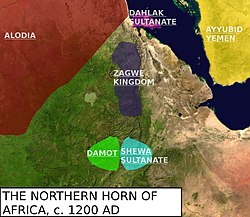Kingdom of Damot
Medieval kingdom in southern Ethiopia from 900 to 1317 From Wikipedia, the free encyclopedia
The Kingdom of Damot (Amharic: ዳሞት) was a medieval kingdom in what is now western Ethiopia.[1] The territory was positioned below the Blue Nile.[2] It was a powerful state that forced the Sultanate of Showa (also called Shewa) to pay tributes. It also annihilated the armies of the Zagwe dynasty that were sent to subdue its territory. Damot conquered several Muslim and Christian territories.[3] The Muslim state Showa and the new Christian state under Yekuno Amlak formed an alliance to counter the influence of Damot in the region.[4]
Kingdom of Damot | |||||||||
|---|---|---|---|---|---|---|---|---|---|
| c. 13th century–c. 16th century | |||||||||
 The kingdom of Damot and its neighbours circa 1200 AD | |||||||||
| Capital | Maldarede 9.39°N 37.56°E | ||||||||
| Common languages | Gonga, and other Omotic languages | ||||||||
| Religion | Paganism, Christianity | ||||||||
| Government | Monarchy | ||||||||
| Motalami | |||||||||
| History | |||||||||
• Established | c. 13th century | ||||||||
• Conquered by Ethiopia | c. 1316 | ||||||||
• Disestablished | c. 16th century | ||||||||
| |||||||||
Some academics have claimed that Damot was equivalent to the Kingdom of Wolaita, with the most famous ruler of Damot, Motolomi Sato, coming from the Wolaita Malla dynasty which ruled from the 13th-16th century, before being replaced by the Tigre Malla dynasty amid the Oromo expansion.[5]: 59
History
The kings of Damot, who bore the title motalami, resided in a town which, according to the hagiography of Tekle Haymanot, was called Maldarede.[6] Damot was conquered by Emperor Amda Seyon in 1316/7. His royal chronicle recounted that "all the people of Damot [came] into my hands; its king, its princes, its rulers, and its people, men and women without number, whom I exiled into another area."[7] Amda Seyon seemingly left the Damotian royal family in power, for the title motälämi continued to be used until the 15th century.[8] al-Mufaddal ibn Abi al-Fada'il in the fourteenth century writes that Damot alongside Harla Kingdom were forced to pay tribute to Abyssinia.[9]
Originally located south of the Abay and west of the Muger River,[10] under the pressure of Oromo attacks the rulers were forced to resettle north of the Abay in southern Gojjam between 1574 and 1606.[11]
Their territory extended east beyond the Muger as far as the Jamma.[10] The province of Damot remained part of the Ethiopian Empire well after the Zemene Mesafint began, unlike other southern regions. The ruler of Damot was typically from Gojjam and held the title Ras.
Religion
The population of Damot adherred to its own religion dominated by a deity called Däsk. This continued on even well after being conquered by the Christian Empire, which repeatedly led to conflict between the locals and the Christian garrison troops.[12] Parts of the population seemingly remained pagan until the late 16th century.[13]
It is claimed in the Hagiography of Tekle Haymanot that the latter managed to convert the ruler of Damot to Christianity.[14]
References
Further reading
Wikiwand in your browser!
Seamless Wikipedia browsing. On steroids.
Every time you click a link to Wikipedia, Wiktionary or Wikiquote in your browser's search results, it will show the modern Wikiwand interface.
Wikiwand extension is a five stars, simple, with minimum permission required to keep your browsing private, safe and transparent.
